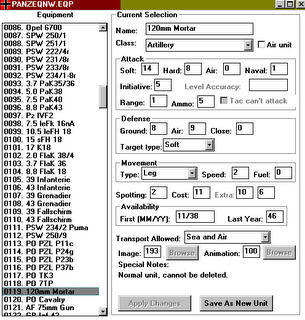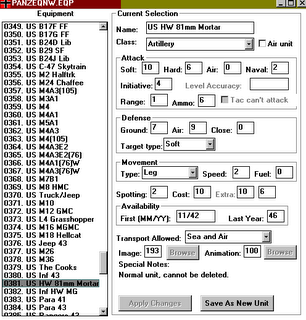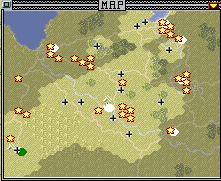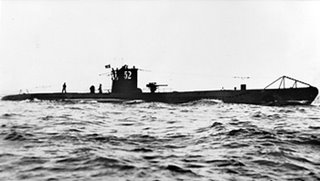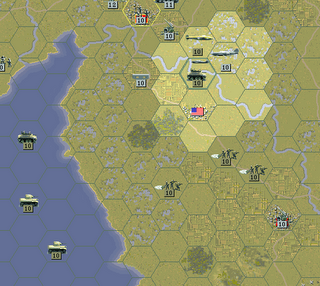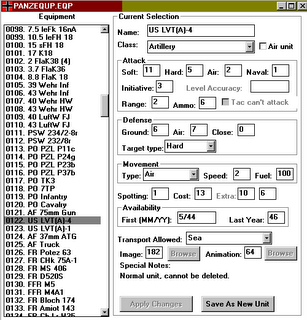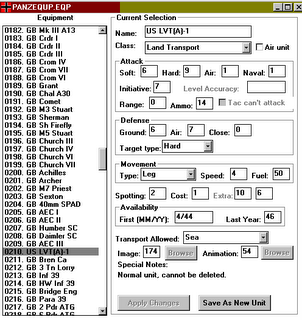The
K.u.k. General WWI campaign already independently had invented
the amphibious LVT idea of 2 air Movement Points (MP) to simulate fast mountain movement of mountain troops. This is a valid solution with our current editing abilities and should work fine in appropriate scenarios but
if we could make a few simple edits to terrain costs we could gain the following improvements:
- Remove the mountaineers' accidental amphibious ability (a side effect of the air movement) and return normal behavior with rivers and oceans
- Allow motor transport of the mountaineers (only available to leg and towed units, not "air" units)
The quick solutions would be to give the mountaineers 2 "towed" MP
if we could make the following simple edits to "towed" terrain costs:
------------Mountain------------Swamp-----
| Dry | Mud | Ice | Dry | Mud | Ice |
| Old | All | All | All | N/A | N/A | N/A |
| New | 1 | 1 | 1 | 2 | 2 | 2 |
These edits would not change towed guns' movement since their 1MP still would be "all" in mountains and "not enough" in swamps (it might allow a desperate retreat into swamps but the "N/A" was never ironclad since guns can enter swamps while transported). K.u.K's mountain troops would be a bit slower than infantry in swamps but (as they are now with air movement) a bit faster in forest, rough, and mountains, while trading undesirable amphibious ability for desirable motor transport ability.
(PS: That's the quick solution. You can tweak it even more if you were willing to re-scale all towed movement to allow a 37mm to go some places that an 8in gun can't.)
Update 8/25/2006Eliminating the Ocean Movement of "Air" MovementWe know that if you give air transport to infantry, they can fly over the ocean.
However, if you assign a truck transport to a plane, the plane
cannot fly over the ocean.
We can turn this restriction to an advantage to rid mountain troops’ “air” movement of its worst amphibious side effect.
In the game purchase screen, you cannot assign transport to units with “air” movement even if they are infantry in the infantry section, but we can use an editor to do so (therefore, such mountain troops should be unpurchasable, at least for the AI).
Simply assigning a truck transport to the mountain unit with “air” movement will prevent any walking-on-the-ocean movement. If you do not like the idea of mountaineers dragging trucks over the Alps, use a mirror unit where the mountain infantry can fight equally well either in their 2MP mountain (“air”) mode or their 3MP leg “transport” mode: The US-Canadian 1st Special Service Force (SSF) “Devil’s Brigade”: Assign this as “transport” to the base unit which is identical except for 2 “air” MP:
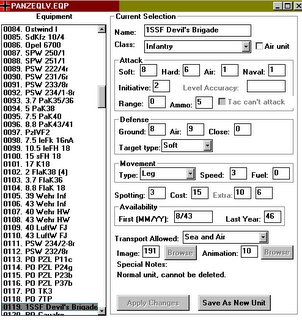
Remember that if the unit embarks from an airfield in standard air transport such as a C-47, it will ditch its land "transport" and after landing be able to float over the ocean again (at least the AI does not use air embarkation but you could set mountain troops to sea transport only).
The Devil’s Brigade raids Narvik: Note that it can move 2 hexes in the mountains but cannot enter the ocean. If it toggles to its 3MP leg “transport,” it can enter the city of Bodo to the West:

This mountain unit still "can cross rivers without delay." It always can move 2 hexes through the toughest terrain (mountain, river, swamp, woods, rough) even during mud and can move 3 hexes in clear terrain. Because this special movement works in woods and swamps too, you could use it more generally for other ranger-type units or guerrillas. Note that this method approximates adding Pacific General's "guide" feature to PG/AG units.
Update 9/7/06Use the green-bordered impassable hex (or an "ocean"-coded hex) for an extreme peak within a larger mountain range and the time it takes to go around it could simulate the obstacle while still allowing mountin troops' faster negotiation of it.
You can change your vote on the newly revised poll choices:

